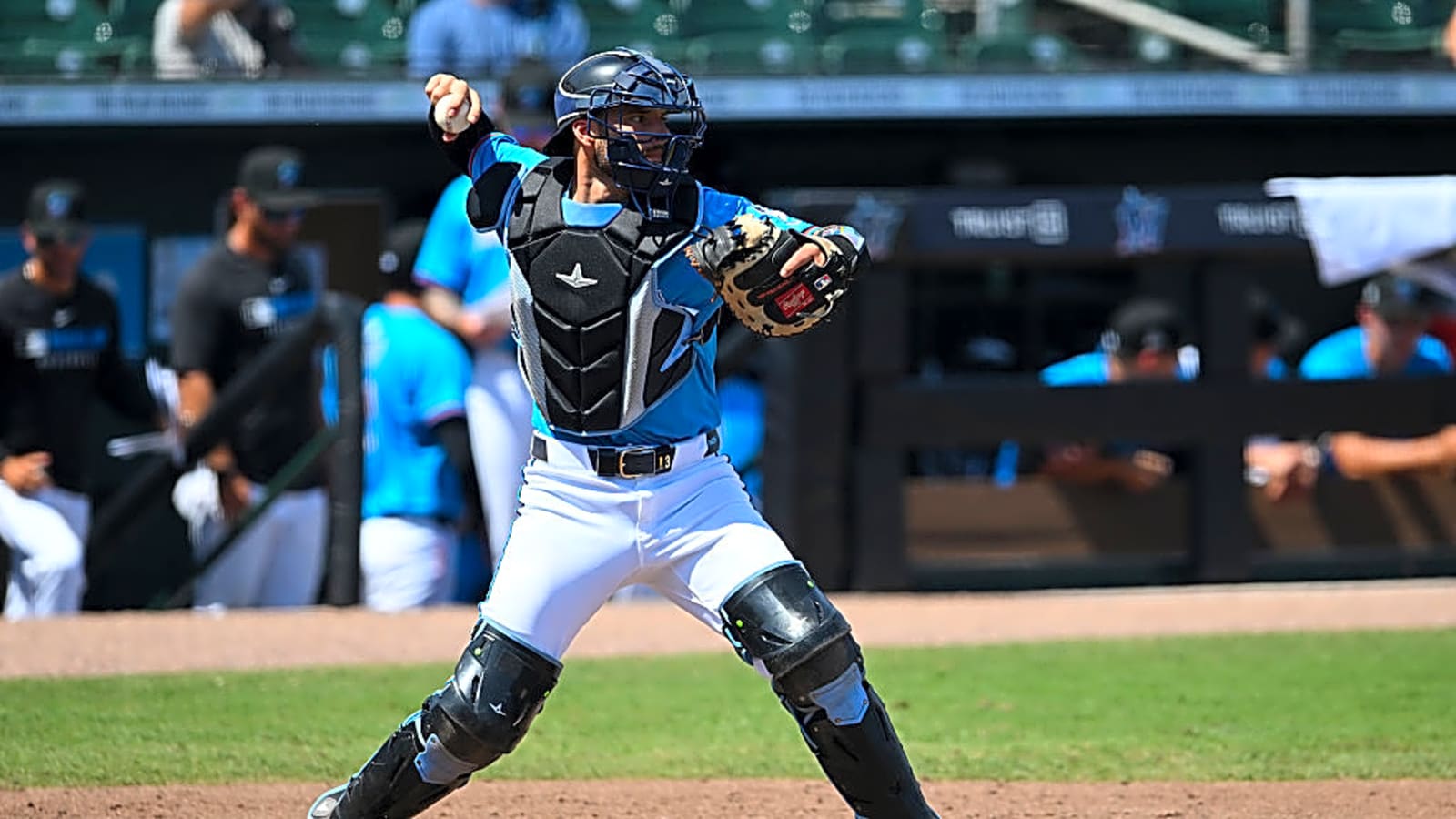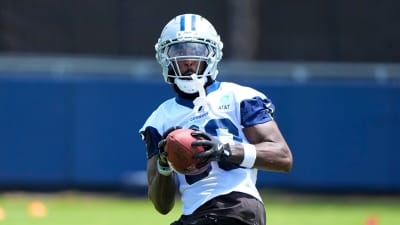
The Miami Marlins are at a crossroads. After years of half-measures and stalled rebuilds, the franchise needs foundational players who can anchor the next era of baseball in Miami.
Catchers who can impact the game on both sides of the ball are among the rarest commodities in the sport, and when they emerge, they often define a team’s identity for years. That’s what makes Joe Mack such a pivotal figure.
Drafted in the first round in 2021 out of Williamsville East High School in New York, Mack has developed at a steady pace, and his blend of defensive polish and offensive potential gives him a chance to be the backbone of the Marlins’ next playoff team.
Stats updated prior to games on Monday, September 8
At the Plate
Mack brings a smooth, left-handed swing that is naturally geared for loft. In his first taste of Triple-A with the Marlins this season, he’s posted a 37.9% groundball rate, evidence of his ability to elevate. More importantly, his swing is particularly effective to the pull side, allowing him to tap into his raw power consistently.
While his 41.9% hard-hit rate is relatively pedestrian for the level, his 18.5% HR/FB rate underscores the impact potential—when Mack gets the ball in the air, it often has a chance to leave the yard.
The offensive questions for Mack center on his approach and a very fringy hit tool. After showing elite patience in Double-A with a 17.9% walk rate, he has looked more aggressive in Triple-A, with his swing rate climbing to 51.9% from 44.4% in the lower level.
That change has coincided with a dip in plate discipline, as his walk rate has fallen to 8.5%. For Mack, the ability to draw walks is paramount because his contact rates remain concerning. His 77.5% zone contact rate at Triple-A is a red flag, and given the uphill nature of his swing path, it’s unlikely he’ll ever reach league-average bat-to-ball ability.
Still, there’s a path forward offensively. By maintaining his ability to pull the ball in the air with authority and recapturing some of the patience he showed in Double-A, Mack can lean into a three-true-outcome profile. If that balance comes together, he has a chance to sneak out 20–25 home runs while supplementing that power with enough walks to provide real value from the catcher position.
Behind the Dish
From the moment Mack entered pro ball, evaluators have praised his maturity and leadership behind the plate—traits that are especially notable given his prep background. Defensively, he brings a well-rounded skill set, but two areas stand out. His receiving ability already grades as well above average, giving pitchers confidence that strikes will be stolen and borderline pitches will go his way.
The real carrying tool, however, is his arm. Mack has been remarkably consistent at shutting down the running game, throwing out 34% of attempted base stealers in 2024 and following that with a 34.4% mark in 2025 while facing more advanced competition at a higher level. That blend of quick transfers, accuracy, and arm strength makes him one of the most effective catch-and-throw backstops in the minors.
Here’s a look at Mack showing off that arm strength in action:
Absolutely insane throw by Joe Mack on a double steal last night. Initially looked to third, saw the runner was almost there and threw a seed flat footed to second base. pic.twitter.com/vg5BKbCQc1
— Aram Leighton (@AramLeighton8) September 5, 2025
One reason Mack hasn’t yet joined the big club in Miami is that he’s still developing the mental side of his defensive game. He remains relatively inexperienced in pitch-calling, and that’s an area that only improves with reps and trust from an organization’s pitchers. For a franchise built on young arms, the Marlins need Mack to continue sharpening his ability to game-plan, sequence, and manage a staff.
Given his trajectory so far, though, it’s easy to see why Mack is so highly regarded defensively and within the industry at large—he currently ranks as the No. 48 prospect at Just Baseball (No. 5 in the Marlins system rankings). With polish in his game management, he has the chance to be one of the better two-way catchers in baseball.
What He Unlocks
Mack’s blend of defensive prowess and a steadily improving offensive profile gives him a real chance to be a cornerstone in the Marlins’ rebuild. Simply put, he offers stability and upside in areas where the current big-league roster is lacking.
Compared to Agustin Ramirez, Miami’s present primary catcher, the gap is striking. Ramirez’s carrying tool has always been the bat—he ranks in the 71st percentile in hard-hit rate and the 90th percentile in bat speed—but his work behind the plate has been a glaring weakness. As a rookie, Ramirez has struggled mightily defensively, sitting in the 1st percentile in both Blocks and Caught Stealing Above Average.
Mack’s arrival can and eventually will change that calculus. His defensive baseline would immediately raise the floor of Miami’s catching corps, while the club could deploy Ramirez in a role better suited to his strengths. Shifting Ramirez into a first base/DH role allows him to focus on his power-driven bat, while Mack and Liam Hicks could shoulder the bulk of the catching responsibilities. That alignment maximizes the value of all three players and provides much-needed defensive credibility behind the dish.
If Mack proves himself as the catcher of the future, Miami suddenly boasts a young positional core that the franchise has not seen since the days of Hanley Ramirez and Dan Uggla. A lineup built around Mack, Ramirez, Otto Lopez, Xavier Edwards, breakout performer Kyle Stowers, and recent call-up Jakob Marsee could give the Marlins a legitimate offensive nucleus to complement their already impressive pitching staff.
The key, of course, is Mack’s continued offensive progression. His 103 wRC+ in Triple-A in 2025 shows he still has work to do, but if he can build on that baseline while maintaining his defensive excellence, he becomes the type of player who accelerates timelines. With Mack in place, Miami’s path from plucky upstart to legitimate playoff contender looks much shorter.
Outlook
Mack may never develop into a perennial All-Star, but the path to becoming an above-average regular is clear: lean into a three-true-outcomes offensive profile while continuing to provide elite defense behind the plate. That formula carries immense value, especially at a position where offensive production is often secondary to defensive stability.
For the Marlins, Mack represents more than just a prospect—he represents a stabilizing force at a position of scarcity. Having a cornerstone catcher for a young, ascending core is a significant step forward in the rebuild. A consistent presence behind the plate raises the club’s floor, while the continuity he can provide year over year with an immensely talented pitching staff has the potential to push the ceiling higher.
Mack’s ascension could also have ripple effects throughout the roster: it could unlock more offensive upside for Ramirez by freeing him to focus strictly on hitting, stabilize and enhance the development of Miami’s young pitchers, and ultimately provide the kind of foundational building block that teams search for during transitional years. If he reaches even a conservative version of his ceiling, Mack has the potential to be the backbone of the next competitive era of Marlins baseball.
More must-reads:
- Yankees ride rookie Cam Schlittler's historic performance to ALDS with Red Sox elimination
- Dodgers announce Game 1 starter vs. Phillies
- The 'MLB playoffs all-time hit leaders' quiz
Breaking News
Trending News
Customize Your Newsletter
 +
+
Get the latest news and rumors, customized to your favorite sports and teams. Emailed daily. Always free!








